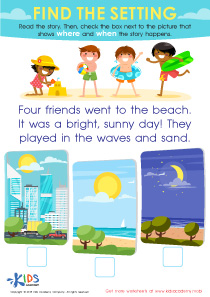Identifying shapes Easy Worksheets for Ages 3-9
3 filtered results
-
From - To
Discover the joy of learning with our "Identifying Shapes Easy Worksheets" designed for children aged 3-9! These engaging resources help young learners recognize and differentiate various shapes, enhancing their foundational math skills. Our fun and interactive worksheets promote creativity and critical thinking through playful illustrations and activities. From circles and squares to triangles and rectangles, your child will enjoy exploring the world of shapes. Perfect for both classroom and home use, these worksheets provide an excellent way to supplement learning while building confidence. Access our easy-to-use, printable worksheets today and make shape identification a delightful experience for your little ones!


Two–Dimensional Shapes: Vertices Printable


Robot Fun Worksheet


Help Sarah Be on Time! Worksheet
Identifying shapes is fundamental to early childhood education as it lays the groundwork for a child's cognitive development. For children ages 3-9, recognizing and understanding shapes is not just a basic skill; it is a key to unlocking various areas of learning, including mathematics, art, and spatial awareness.
Firstly, recognizing shapes helps children develop critical thinking and problem-solving skills. When they learn to distinguish between circles, squares, and triangles, they start to categorize and analyze their environment, fostering essential analytical skills.
Secondly, early shape identification supports the understanding of more complex mathematical concepts. Shapes are foundational in geometry, and grasping these concepts early on can help ease children into more challenging mathematical tasks later in their education.
Additionally, engaging with shapes through play and activities promotes fine motor skills and creativity. Activities like building with blocks, drawing shapes, or engaging in arts and crafts enhance physical coordination and inspire imaginative play.
Lastly, recognizing shapes fosters communication skills, as children describe their findings and experiences, ultimately enhancing their language development. Therefore, parents and teachers should prioritize shape identification as a crucial aspect of early learning, as it bridges various areas of educational growth and enriches a child's learning experience.
 Assign to My Students
Assign to My Students








.jpg)












